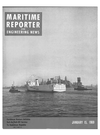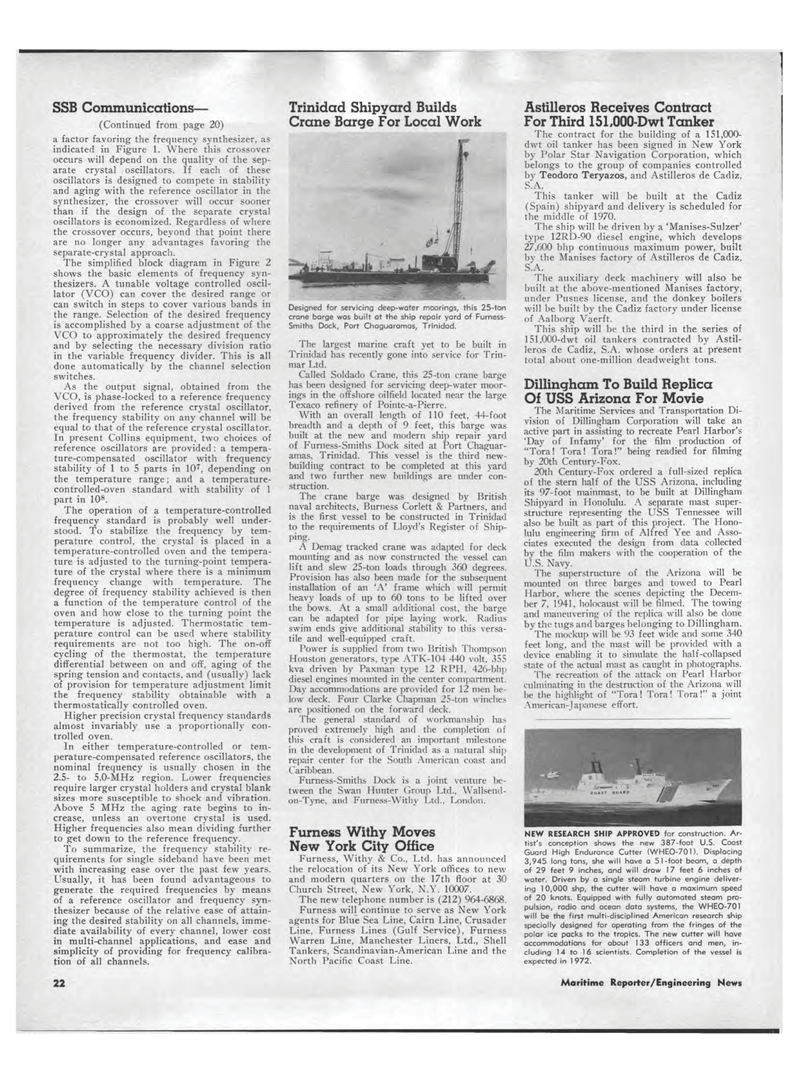
Page 20: of Maritime Reporter Magazine (January 15, 1969)
Read this page in Pdf, Flash or Html5 edition of January 15, 1969 Maritime Reporter Magazine
SSB Communications? (Continued from page 20) a factor favoring the frequency synthesizer, as indicated in Figure 1. Where this crossover occurs will depend on the quality of the sep-arate crystal oscillators. If each of these oscillators is designed to compete in stability and aging with the reference oscillator in the synthesizer, the crossover will occur sooner than if the design of the separate crystal oscillators is economized. Regardless of where the crossover occurs, beyond that point there are no longer any advantages favoring the separate-crystal approach. The simplified block diagram in Figure 2 shows the basic elements of frequency syn-thesizers. A tunable voltage controlled oscil-lator (VCO) can cover the desired range or can switch in steps to cover various bands in the range. Selection of the desired frequency is accomplished by a coarse adjustment of the VCO to approximately the desired frequency and by selecting the necessary division ratio in the variable frequency divider. This is all done automatically by the channel selection switches. As the output signal, obtained from the VCO, is phase-locked to a reference frequency derived from the reference crystal oscillator, the frequency stability on any channel will be equal to that of the reference crystal oscillator. In present Collins equipment, two choices of reference oscillators are provided: a tempera-ture-compensated oscillator with frequency stability of 1 to 5 parts in 107, depending on the temperature range; and a temperature-controlled-oven standard with stability of 1 part in 108. The operation of a temperature-controlled frequency standard is probably well under-stood. To stabilize the frequency by tem-perature control, the crystal is placed in a temperature-controlled oven and the tempera-ture is adjusted to the turning-point tempera-ture of the crystal where there is a minimum frequency change with temperature. The degree of frequency stability achieved is then a function of the temperature control of the oven and how close to the turning point the temperature is adjusted. Thermostatic tem-perature control can be used where stability requirements are not too high. The on-off cycling of the thermostat, the temperature differential between on and off, aging of the spring tension and contacts, and (usually) lack of provision for temperature adjustment limit the frequency stability obtainable with a thermostatically controlled oven. Higher precision crystal frequency standards almost invariably use a proportionally con-trolled oven. In either temperature-controlled or tem-perature-compensated reference oscillators, the nominal frequency is usually chosen in the 2.5- to 5.0-MHz region. Lower frequencies require larger crystal holders and crystal blank sizes more susceptible to shock and vibration. Above 5 MHz the aging rate begins to in-crease, unless an overtone crystal is used. Higher frequencies also mean dividing further to get down to the reference frequency. To summarize, the frequency stability re-quirements for single sideband have been met with increasing ease over the past few years. Usually, it has been found advantageous to generate the required frequencies by means of a reference oscillator and frequency syn-thesizer because of the relative ease of attain-ing the desired stability on all channels, imme-diate availability of every channel, lower cost in multi-channel applications, and ease and simplicity of providing for frequency calibra-tion of all channels. Trinidad Shipyard Builds Crane Barge For Local Work J* \ *i fii Designed for servicing deep-water moorings, this 25-ton crane barge was built at the ship repair yard of Furness-Smiths Dock, Port Chaguaramas, Trinidad. The largest marine craft yet to be built in Trinidad has recently gone into service for Trin-mar Ltd. Called Soldado Crane, this 25-ton crane barge has been designed for servicing deep-water moor-ings in the offshore oilfield located near the large Texaco refinery of Pointe-a-Pierre. With an overall length of 110 feet, 44-foot breadth and a depth of 9 feet, this barge was built at the new and modern ship repair yard of Furness-Smiths Dock sited at Port Chaguar-amas, Trinidad. This vessel is the third new-building contract to be completed at this yard and two further new buildings are under con-struction. The crane barge was designed by British naval architects, Burness Corlett & Partners, and is the first vessel to be constructed in Trinidad to the requirements of Lloyd's Register of Ship-ping. A Demag tracked crane was adapted for deck mounting and as now constructed the vessel can lift and slew 25-ton loads through 360 degrees. Provision has also been made for the subsequent installation of an 'A' frame which will permit heavy loads of up to 60 tons to be lifted over the bows. At a small additional cost, the barge can be adapted for pipe laying work. Radius swim ends give additional stability to this versa-tile and well-equipped craft. Power is supplied from two British Thompson Houston generators, type ATK-104 440 volt. 355 kva driven by Paxman type 12 RPH. 426-bhp diesel engines mounted in the center compartment. Day accommodations are provided for 12 men be-low deck. Four Clarke Chapman 25-ton winches are positioned on the forward deck. The general standard of workmanship has proved extremely high and the completion of this craft is considered an important milestone in the development of Trinidad as a natural ship repair center for the South American coast and Caribbean. Furness-Smiths Dock is a joint venture be-tween the Swan Hunter Group Ltd., Wallsend-on-Tyne, and Furness-Withy Ltd., London. Furness Withy Moves New York City Office Furness, Withy & Co., Ltd. has announced the relocation of its New York offices to new and modern quarters on the 17th floor at 30 Church Street, New York, N.Y. 10007. The new telephone number is (212) 964-6868. Furness will continue to serve as New York-agents for Blue Sea Line, Cairn Line, Crusader Line, Furness Lines (Gulf Service), Furness Warren Line, Manchester Liners, Ltd., Shell Tankers, Scandinavian-American Line and the North Pacific Coast Line. Astilleros Receives Contract For Third 151,000-Dwt Tanker The contract for the building of a 151,000-dwt oil tanker has been signed in New York by Polar Star Navigation Corporation, which belongs to the group of companies controlled by Teodoro Teryazos, and Astilleros de Cadiz, S.A. This tanker will be built at the Cadiz (Spain) shipyard and delivery is scheduled for the middle of 1970. The ship will be driven by a 'Manises-Sulzer' type 12RD-90 diesel engine, which develops 27,600 bhp continuous maximum power, built by the Manises factory of Astilleros de Cadiz, S.A. The auxiliary deck machinery will also be built at the above-mentioned Manises factory, under Pusnes license, and the donkey boilers will be built by the Cadiz factory under license of Aalborg Vaerft. This ship will be the third in the series of 151,000-dwt oil tankers contracted by Astil-leros de Cadiz, S.A. whose orders at present total about one-million deadweight tons. Dillingham To Build Replica Of USS Arizona For Movie The Maritime Services and Transportation Di-vision of Dillingham Corporation will take an active part in assisting to recreate Pearl Harbor's 'Day of Infamy' for the film production of "Tora! Tora! Tora!" being readied for filming by 20th Century-Fox. 20th Century-Fox ordered a full-sized replica of the stern half of the USS Arizona, including its 97-foot mainmast, to be built at Dillingham Shipyard in Honolulu. A separate mast super-structure representing the USS Tennessee will also be built as part of this project. The Hono-lulu engineering firm of Alfred Yee and Asso-ciates executed the design from data collected by the film makers with the cooperation of the U.S. Navy. The superstructure of the Arizona will be mounted on three barges and towed to Pearl Harbor, where the scenes depicting the Decem-ber 7, 1941, holocaust will be filmed. The towing and maneuvering of the replica will also be done by the tugs and barges belonging to Dillingham. The mockup will be 93 feet wide and some 340 feet long, and the mast will be provided with a device enabling it to simulate the half-collapsed state of the actual mast as caught in photographs. The recreation of the attack on Pearl Harbor culminating in the destruction of the Arizona will be the highlight of "Tora! Tora! Tora!" a joint American-Japanese effort. NEW RESEARCH SHIP APPROVED for construction. Ar-tist's conception shows the new 387-foot U.S. Coast Guard High Endurance Cutter (WHEO-701). Displacing 3,945 long tons, she will have a 51-foot beam, a depth of 29 feet 9 inches, and will draw 17 feet 6 inches of water. Driven by a single steam turbine engine deliver-ing 10,000 shp, the cutter will have a maximum speed of 20 knots. Equipped with fully automated steam pro-pulsion, radio and ocean data systems, the WHEO-701 will be the first multi-disciplined American research ship specially designed for operating from the fringes of the polar ice packs to the tropics. The new cutter will have accommodations for about 133 officers and men, in-cluding 14 to 16 scientists. Completion of the vessel is expected in 1 972. 22 Maritime Reporter/Engineering News

 19
19

 21
21
